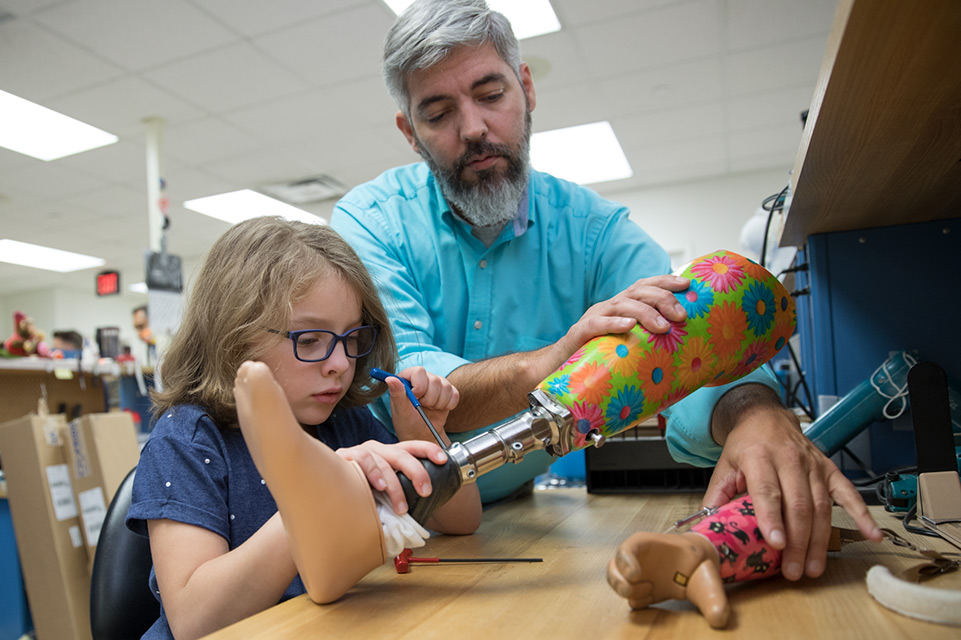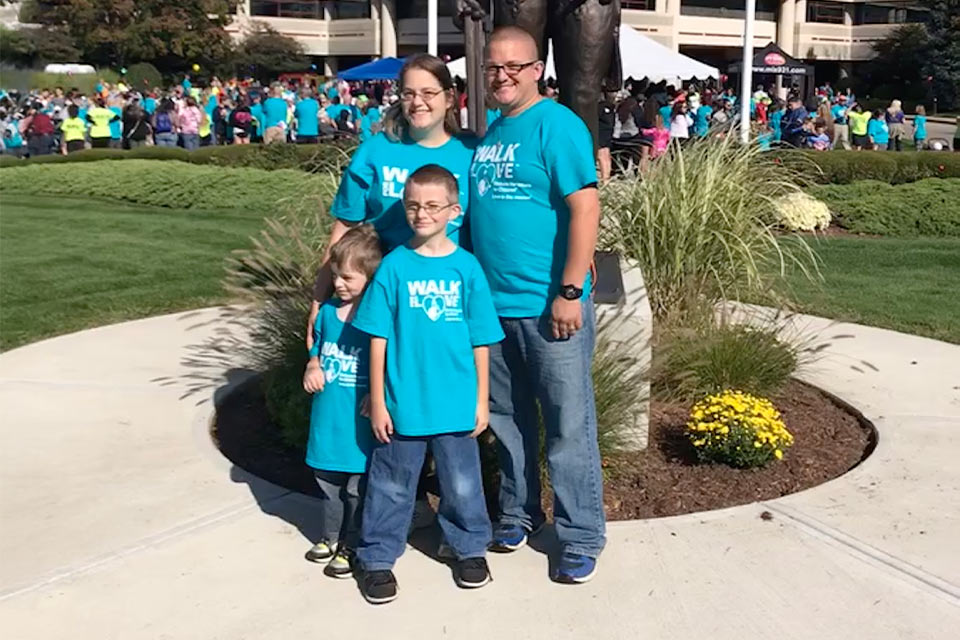Limb Length Discrepancy
Personalized Care by World-Class, Nationally-Recognized Physicians With Vast Experience Treating Limb Length Discrepancies
A limb-length discrepancy can occur in either the arms or legs, and involves one limb being either too long or too short.
Small differences in limb length are common and may pose little risk or problem for your child, but these discrepancies can also increase as your child grows. Your doctor can help determine whether or not this is a concern.
Larger limb length discrepancies could have a significant impact on your child's quality of life, especially if the difference is in the legs. Many children with leg length differences have a limp and difficulty walking or running. They can also develop hip, knee and back pain as they get older and approach adulthood.
Children with limb length discrepancies are often born with the condition, although it may not be obvious to parents until they begin to crawl or walk. Some children develop limb differences over time as a result of illness or injury.
Our Approach to Treatment
Shriners Children's skilled physicians have vast experience diagnosing and treating limb length discrepancies of the legs and arms using innovative treatments to give your child the best possible quality of life.
In many situations, your child's leg length discrepancy may be managed by a shoe lift until they are old enough to have surgery to correct the limb length discrepancy. Limb lengthening may be part of the treatment that is required, including extended physical therapy. If that is the case, the limb lengthening team will work with you preparing you and your child for the process. In some circumstances, a visit with one of the master technicians in our Pediatric Orthotics and Prosthetics Services department might be the best option.
A diagnosis of a limb length discrepancy, especially if it is large, can be stressful for the entire family. Those stressors can include fears about your child's future and insecurity about making the right decisions. Be reassured that you'll have a Shriners Children's care team to guide you. Your child’s surgeons, physical and occupational therapists, and other care providers understand the concerns of children and parents navigating this journey.
We’ve seen children with limb length discrepancies successfully progress through childhood, as they become busy preschoolers, young sports stars and active teens confidently socializing with friends and succeeding in all aspects of life. Here you can learn more about the condition and the treatment options that are available.
Specific treatments and services may vary by location. Please contact a specific location for more information.
Causes
There are many causes of limb length discrepancies including:
- Bone diseases or dysplasias, including Ollier disease (multiple enchondromas, multiple hereditary exostoses, and neurofibromatosis).
- Infections in the bone that cause growth plate disturbances.
- Neurologic conditions, such as cerebral palsy and spasticity.
- Conditions that cause joint inflammation, such as juvenile idiopathic arthritis.
- Trauma or injury to a bone. When it heals, it is shorter or grows faster than its pair. This is more likely to happen with compound fractures near or in the growth plates.
- Conditions your child is born with, such as clubfoot, hip dysplasia and proximal femoral focal deficiency, that affect the growth on one side of a child's body or in a specific bone.
- A tumor or surgery to remove a tumor, which can temporarily or permanently affect growth in nearby body parts.
In many cases, these conditions are present at birth, but the limb length discrepancy may not become noticeable until later in childhood.
Leg Length Discrepancy Conditions
Physeal arrest: This is a problem caused by an injury to the growth plate that causes part or all of it not to grow. It can be caused by a fracture, infection, tumor, cyst or other problems and can lead to a shorter or deformed limb.
Acquired limb length discrepancy (LLD): This happens when one of your child's limbs grows more slowly or quickly than its pair because of a problem that happens and continues after birth. The most common causes are trauma, infection, tumor, metabolic or developmental problems.
Congenital limb length discrepancy: This condition occurs in your child when one limb is shorter or longer than its pair before they are born.
Congenital short femur: This is a condition your child is born with in which the thigh and tissues around the thigh bone, called the femur, are shorter than normal. It commonly occurs with other problems, such as a shallow hip (acetabular dysplasia), external rotation, proximal femoral deformity and knock knee. Children with this condition often have a condition called fibular hemimelia as well.
Proximal femoral focal deficiency: This is also a condition your child may be born with. With it, the thigh and tissues around the thigh bone, called the femur, are shorter than normal. It is typically more severe than congenital short femur and also occurs with other problems, such as a shallow hip (acetabular dysplasia), external rotation, proximal femoral deformity and knock knee. Children with this condition often have a condition called fibular hemimelia as well.
Tibial hemimelia: A rare limb length discrepancy that affects the lower leg, this is a condition a child is born with in which all or part of the larger bone in the lower leg, called the tibia, does not form. That leg typically is shorter and may also have an abnormal knee or ankle. Children with this condition may also have clubfoot and have missing or additional toes.
Fibular hemimelia: Similar to tibial hemimelia, this condition also affects the lower leg. However, in this situation, when a child is born, the smaller bone of the lower leg, called the fibula, has not fully formed or is missing. That leg typically is shorter and may also have an abnormal knee or ankle. Children with this condition may also have clubfoot and have missing or additional toes.
Posteromedial bowing of the tibia: With this condition, both of the bones in your child's lower leg, the fibula and the tibia, are affected. Your child's lower leg and ankle are tilted outward and forward, and it is typically shorter than its pair. The tilt might go away before the child turns 8.
Hemihypertrophy: This is a rare condition in which one side of your child's body grows larger than the other. Because of the condition, one leg and arm are typically bigger than the other. It is typically caused by certain types of tumors.
Other conditions treated
- Skeletal dysplasia
- Metaphyseal dysplasia
- Epiphyseal dysplasia
- Achondroplasia
- Dysplasia epiphysealis hemimelica (Trevor's disease)
- Osteochondromatosis (multiple hereditary exostoses - MHE)
Arm Length Discrepancy Conditions
Radial deficiency: The forearm bone on the thumb side (the radius) and soft tissues of your child's forearm fail to develop properly. This causes their hand to be bent inward, giving it the appearance of a “club hand.” The forearm also may be shorter. A radial deficiency can sometimes be associated with other issues, including TAR syndrome
Ulnar deficiency: The forearm bone on the pinkie side and soft tissues of your child's forearm fail to develop properly, causing the wrist to bend toward the outside – the opposite direction to that seen with a radial deficiency. In the mildest cases, there may be only a small tilt of the wrist. In the most severe cases, the forearm bone may be missing entirely.
Madelung deformity: Part of the forearm bone on the thumb side (radius) stops growing early, while the forearm bone on the pinkie side (ulna) continues to grow and dislocates, leading to bad alignment of the wrist joint.
Shriners Hospital became a safe place where other kids looked like me and understood how I felt.

Help to Even Things Out
Innovative Treatments
View All Related Treatments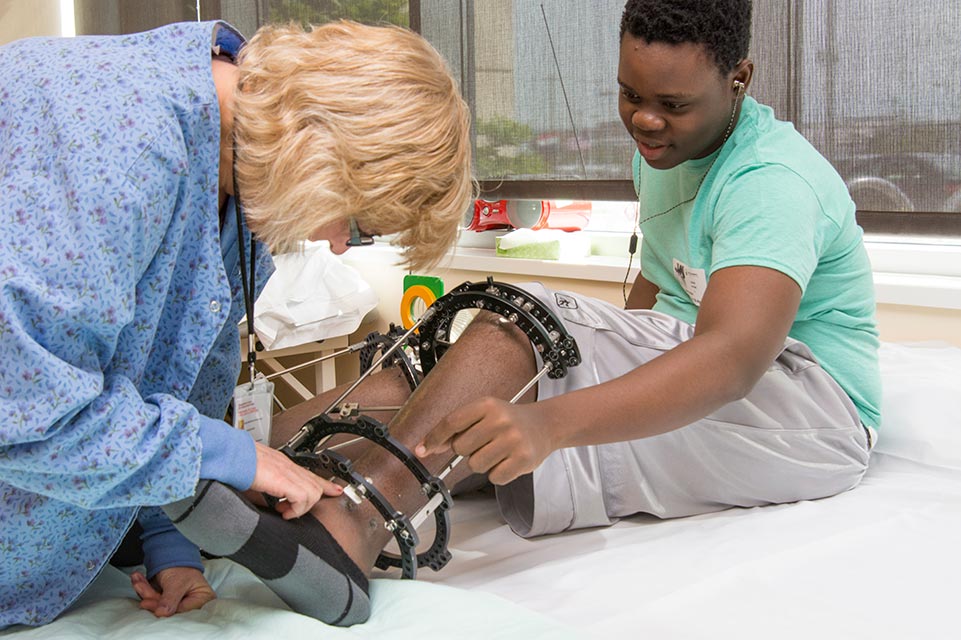
Physical Therapy with an External Fixator
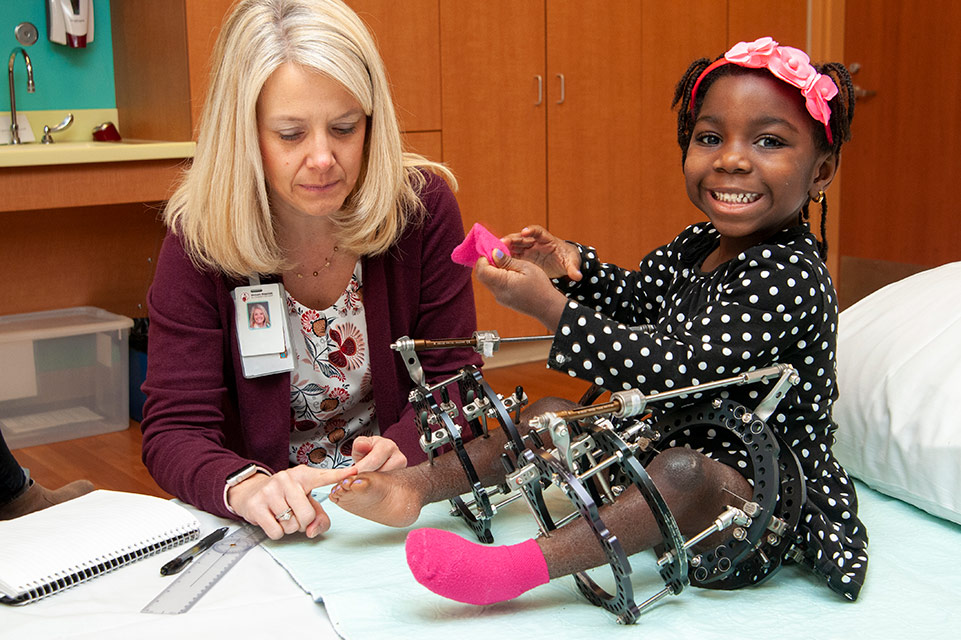
Physical Therapy with an Ellipse Nail
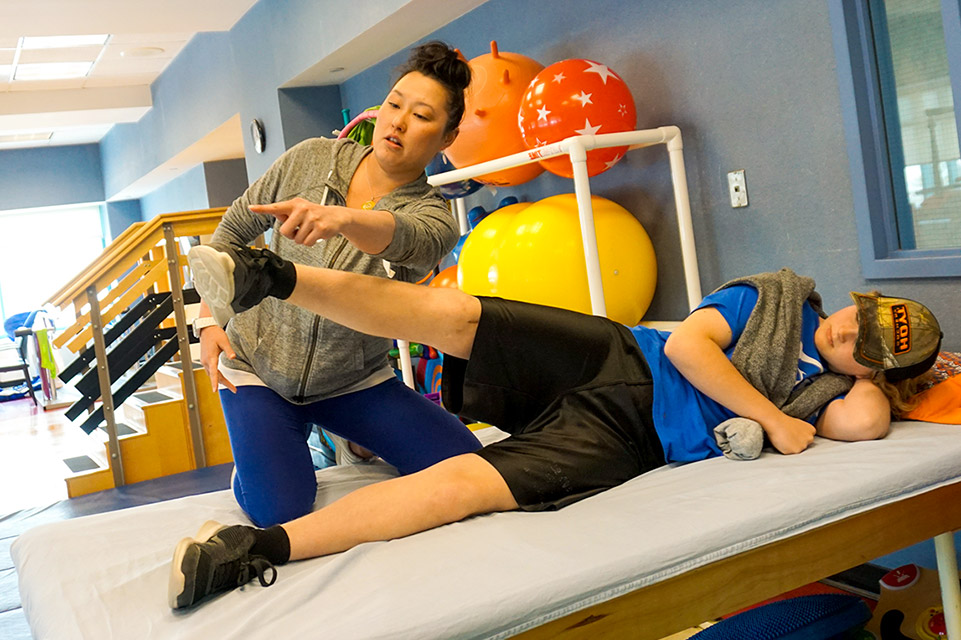
Pediatric Orthotic and Prosthetic Services (POPS)
